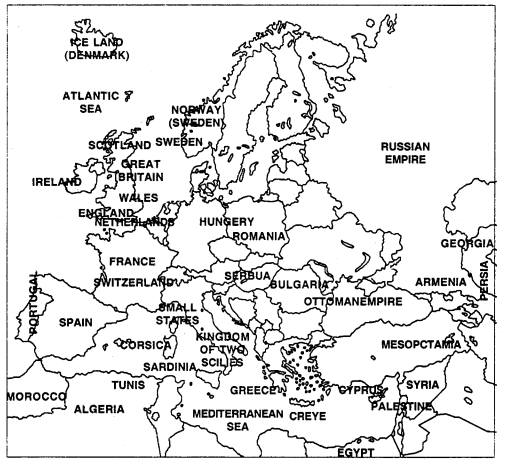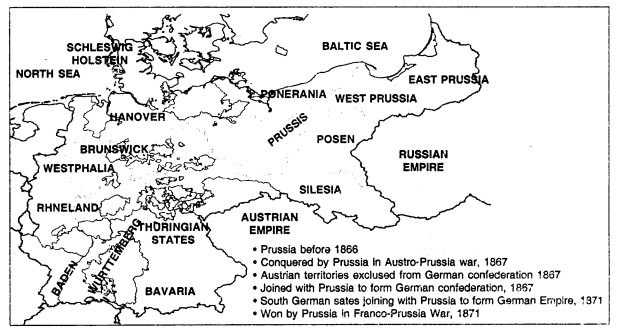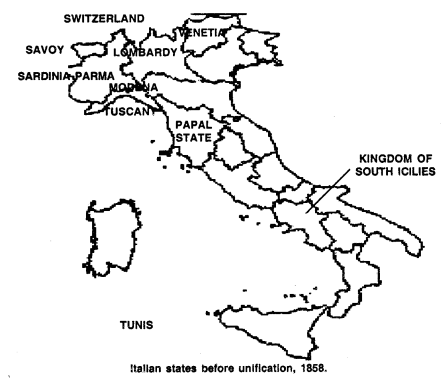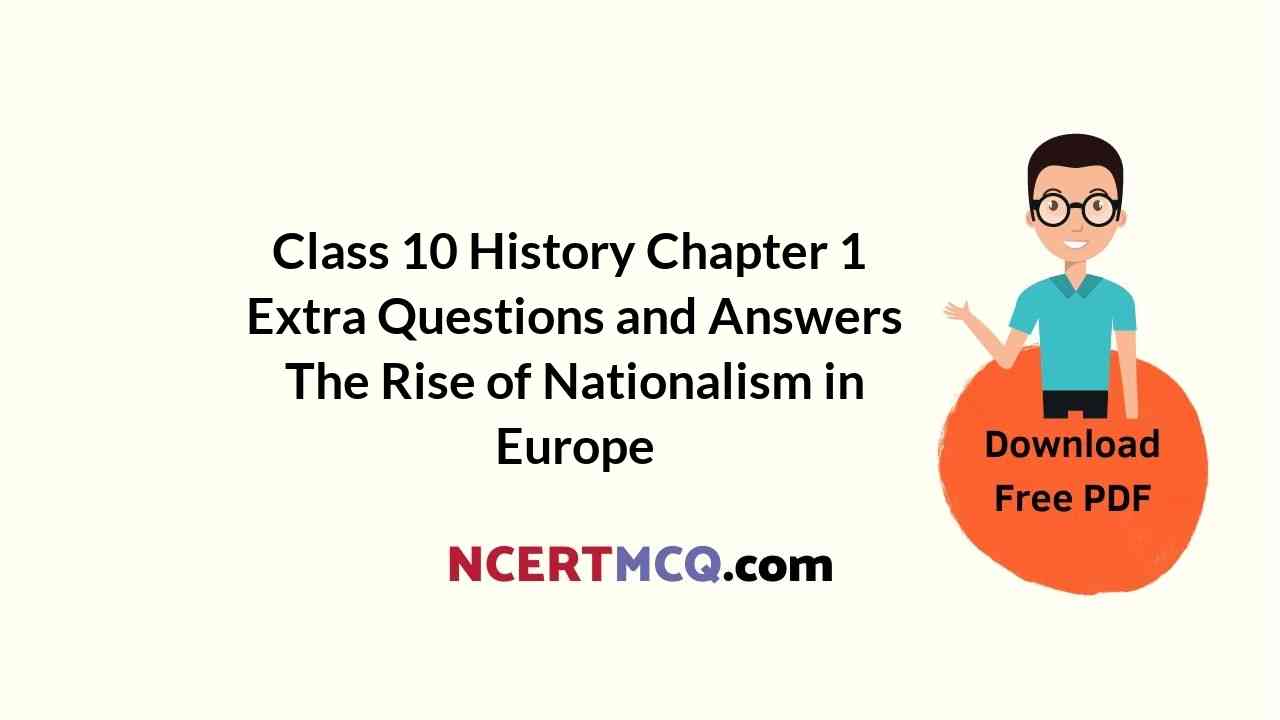Check the below Online Education NCERT MCQ Questions for Class 10 History Chapter 1 Extra Questions and Answers The Rise of Nationalism in Europe Pdf free download. https://ncertmcq.com/extra-questions-for-class-10-social-science/
Online Education for The Rise of Nationalism in Europe Class 10 Extra Questions History Chapter 1
Very Short Extra Questions For Class 10 History Chapter 1 Question 1.
Why was the idealistic liberal-democratic sentiment of the first half of the 19th century unable to retain its fervour?
Answer:
The liberal-democratic states, with their extreme nationalism, became intolerant of each other and began moving towards imperialism to further their aims.
Class 10 History Chapter 1 Extra Questions And Answers Question 2.
How were the French armies initially welcomed as they marched into numerous territories of Europe during the Napoleonic expansion?
Answer:
Harbingers of liberty.
Class 10 History Chapter 1 Extra Questions And Answers Pdf Question 3.
What did the Vienna Peace Settlement signify?
Answer:
Fall of Napoleon (1814 -15).
Nationalism In Europe Class 10 Extra Questions Question 4.
Mention the period of the unification of Italy.
Answer:
1859 -1870.
History Class 10 Chapter 1 Extra Question Answer Question 5.
Mention the period of the unification of Germany.
Answer:
1866 -1871.
The Rise Of Nationalism In Europe Extra Questions Question 6.
What do you mean by suffrage?
Answer:
Suffrage means right to vote, also called franchise.
![]()
Nationalism In Europe Extra Questions Question 7.
Which European powers attended the Congress of Vienna (1815)?
Answer:
Britain, Russia, Prussia, Austria.
Source Based Questions History Class 10 Chapter 1 Question 8.
What was the main intention of the Treaty of Vienna (1815)?
Answer:
To restore the erstwhile monarchies in Europe and create a new conservative order.
Class 10 History Chapter 1 One Mark Questions Question 9.
When was the restored Bourbon dynasty overthrown in France?
Answer:
In July 1830.
Rise Of Nationalism In Europe Extra Questions Question 10.
Who had said that when France sneezes, the rest of Europe catch cold?
Answer:
Metternich.
Class 10 History Chapter 1 Extra Questions Question 11.
Name the English poet who had participated in the Greek war of Independence.
Answer:
Lord Byron, he died, while participating in the war, of fever in 1824.
The Rise Of Nationalism In Europe Class 10 Extra Questions Question 12.
Which German philosopher claimed that the true German culture was to be discovered among the common people?
Answer:
Johann Gottfried Herder (1744 -1803).
Class 10 History Chapter 1 Short Questions And Answers Question 13.
Who was Delacroix?
Answer:
Delacroix was all-important French romantic painter. He depicted the incident of the massacre at Chios.
Extra Questions For Class 10 History Chapter 1 Question 14.
Who was Karol Kurpinski ?
Answer:
Kurpinski, a literary artist of Poland, used operas and music and folk dances in nationalist struggle.
Class 10 History Chapter 1 Very Short Questions And Answers Question 15.
State any two features of the 1848 French Republic.
Answer:
- It granted suffrage to all adult males;
- It guaranteed right to work.
![]()
Question 16.
Who was Louise Otto-Peters?
Answer:
Louise Otto-Peters (1819 – 1895) was a political activist who founded a women’s journal, and later, a feminist political association.
Question 17.
Who was Victor Emmanuel II?
Answer:
Victor Emmanuel II was the Italian king who sought to unify the Italian states through war in the wake of 1931 and 1848 uprisings.
Question 18.
What was Garibaldi’s contribution?
Answer:
Apart from regular troops, a large number of armed volunteers under Garibaldi (1809 – 1882) marched into South Itay. He succeeded in enlisting the support of the local people, the peasants especially.
Question 19.
What did Murianne and Germania Mean?
Answer:
They were allegories representing the French and the German nations.
Question 20.
What did the broken chains symbolise?
Answer:
Broke chains symbolise a state of being free.
Question 21.
Mention the mission of the French revolutionaries they had sought to dream.
Answer:
The revolutionaries further declared it was the mission and the destiny of the French nation to liberate the peoples of Europe from despotism, in other words, to help other peoples of Europe to become nations. Their activities and campaigns prepared the way for the French armies which moved into Holland, Belgium Switzerland and much of Italy in the 1790. With the outbreak of the revolutionary wars, the French armies began to carry the idea of nationalism abroad.
Question 22.
Why the initial enthusiasm in the areas where the French armies marched turned into hostility?
Answer:
Initially, in many places such as Holland and Switzerland and in cities such as Brussel, Mainz, Milan, and Warsaw, the French armies were welcomed as harbingers of liberty. But the initial enthusiasm soon turned to hostility, as it became clear that the new administrative arrangements did not go hand in hand with political freedom. Increased taxation, censorship, forced conscription into the French armies required to conquer the rest of Europe, all seemed to outweigh the advantages of the administrative changes.
![]()
Question 23.
what types of social groups emerged as a result of industrialisation in Europe?
Answer:
industrialisation began in England in the second half of the eighteenth century, but in France and parts of the German states, it occurred only during the nineteenth century. In its wake, new social groups came into being a working-class population, and middle classes made up of industrialists, businessmen, professionals.
In Central and Eastern Europe, these groups were smaller in number till late nineteenth century. It was among the educated, liberal middle classes that ideas of national unity following the abolition of aristocratic privileges gained popularity.
Question 24.
Can you mention obstacles to economic exchanges which Napoleon’s administrative measure had created?
Answer:
Napoleon’s administrative measures had created countless principalities, each possessing its own currency, weights, and measures. This created a lot of obstacles in exchanges. A merchant travelling in 1833 from Hamburg to Nuremberg to sell his goods would have had to pass through 11 customs barriers and pay a customs duty of about 5 per cent at each one of them.
Duties were often levied according to the weight or measurement of the goods. As each region had its own system of weights measures, this involved time-consuming calculation. The measure of cloth, for example, was the Elle which in each region stood for a different length An Elle of textile material bought in Frankfurt would get you 54.7 cm of cloth, in Mainz 55.1 cm, in Nuremberg 65.6 cm, in Freiburg 53.5 cm.
Question 25.
“The 1830s were years of great economic hardships in Europe.” Elucidate.
Answer:
The 1830s’ were years of great economic hardship in Europe. The first half of the nineteenth century saw an enormous increase in population all over Europe. In most countries, there were more seekers of jobs than employment. Population from rural areas migrated to the cities to live in overcrowded slums. Small producers in towns were often faced with stiff competition from imports of cheap machine-made goods from England.
Europe where the aristocracy still enjoyed power, peasants struggled under the burden of feudal dues and obligations. The rise of food prices or a year of bad harvest led to widespread pauperism in town and country. The year 1848 was one such year. Food shortages and widespread unemployment brought the population of Paris out on the roads.
Question 26.
Describe the cause of the Silesian weavers uprising. Comment on the viewpoint of the journalist Wolff.
Answer:
Earlier, in 1845, weavers in Silesia had led a revolt against contractors who supplied.
Question 27.
Mention the meaning of the symbols together with their significance.
Answer:
The following are the symbols and their respective Significance.
| Attribute | significance |
| Broken chains | Being freed |
| Breastplate with eagle | Symbol of the German empire-strength |
| Crown of oak leases | Heroism |
| Sword | Readiness to fight |
| Olive branch around the sword | Willingness to make peace |
| Black, red arid gold tricolour | Flag of the liberal – nationalists in 1848, banned by the Dukes of the German states |
| Rays of the rising sun | Beginning of a new era |
them raw material and gave them orders for finished textile but drastically reduced their payments. On 4 June at 2 p.m. a large crowd of weavers emerged from the homes and marched in pairs up to the mansion of their contractor demanding higher wages.
They were treated with scorn and threats alternately. Following this, a group of them forced their way into the house, smashed its elegant windowpanes, furniture, porcelain… another group broke into the storehouse and plundered it of supplies of cloth which they tore to shreds… The contractor fled with his family to a neighbouring village which, however, refused to shelter such a person. He returned 24 hours later having requisitioned the army. In the exchange that followed, eleven weavers were shot.
The journalist Wilhelm Wolff described the events in Silesian village as follows:
“In these villages (with 18,000 inhabitants cotton weaving is the most widespread occupation. The misery of the workers is extreme. They desperate need for jobs has been taken advantage of by the contractors to reduce the prices of the goods they order”.
![]()
Question 28.
How did the European nationalism lead to imperialism?
Answer:
Nationalism, aligned with imperialism, led Europe to disaster in 1914. But meanwhile, many countries in the world which had been colonised by the European powers in the nineteenth century began to oppose imperial domination. The anti-imperial movements that developed everywhere were nationalist, in the sense that they all struggled to form independent nation-states, and were inspired by a sense of collective rational unity, forged in confrontation with imperialism.
European ideas of nationalism were nowhere replicated, for people everywhere developed their own specific variety of nationalism. But the idea that societies should be organised into ‘nation-states’ came to be accepted as natural and universal. Imperialism was the natural outcome of nationalism. Britain, France and other European powers had their colonies in most of Asia and Africa. Their mutual rivalries led to war in 1914.
Question 28.
“The revolution of 1848 paved way for national consciousness in Europe.” Explain.
Answer:
The Revolution of 1848 in Central Europe marked the awakening of various peoples to national consciousness. In that year both the Germans and the Italians began their movements for unification and for the creation of nation-states. Although the attempts at revolution failed in 1848, the movements gathered strength in subsequent years. After much political agitation and several wars, an Italian kingdom was created in 1861 and a German empire in 1871.
Other central European peoples who agitated for national independence in 1848 include the Poles, whose territory was divided among Russia, Germany, and Austria; the Czechs and the Hungarians, subjects of the Austrian monarchy; and the Christian peoples living in the Balkan Peninsula under the rule of the Ottoman Sultan. The events in Europe between 1878 and 1918 were shaped largely by the nationalist aspirations of these peoples and their desire to form nation-state, independent of the empires of which they had been part.
Question 29.
Discuss the importance of language and popular traditions in the creation of national identity.
Answer:
The emphasis on vernacular and the collection of local folklore carried the modern nationalist message to large audiences who were mostly illiterate. This was especially so in the case of Poland, which had been partitioned at the end of the eighteenth century by the Great Powers – Russia, Prussia and Austria.
Even though Poland no longer existed as an independent territory, national feelings were kept alive through music and language. Karol Kurpinski, for example, celebrated the national struggle through his operas and music, turning folk dances like the polonaise and mazurka into nationalist symbols.
Language too played an important role in developing nationalist sentiments. After Russian occupation, the Polish language was forced out of schools and the Russian language was imposed everywhere. In 1831, an armed rebellion against Russian rule took place which as ultimately crushed following this, many members of the clergy in Poland began to use Language as a weapon of national resistance.
Polish was used for Church gatherings and all religious instruction. As a result, a large number of priests and bishops were put in jail, sent to Siberia by the Russian authorities as punishment for their refusal to preach in Russian. The use of Polish came to be seen as a symbol of the struggle against Russian dominance. The Grimm brothers of Germany, of early 19th country, is another example.
Question 30.
Summarize the contribution of Mazzini in the Italian revolution.
Answer:
During the years following 1815, there rose secret societies to train revolutionaries and spread their ideas. One such individual was the Italian revolutionary Giuseppe Mazzini. Born in Genoa in 1807, he became a member of the secret society of the Carbonari. As a young man of 24, he was sent into exile in 1831 for attempting a revolution in Liguria. He subsequently founded two more underground societies, first, Young Italy in Marseilles, and then, Young Europe in Berne, whose members were like-minded young men from Poland, France, Italy and the German states.
Mazzini believed that God had intended nations to be the natural units of mankind. So Italy could not continue to be a patchwork of small stales and kingdoms. It had to be forged into a single unified republic within a wider alliance of nations. This unification alone could be the basis of Italian liberty.
Following his model, secret societies were set up in Germany, France, Switzerland and Poland. Mazzini’s relentless opposition to monarchy and his vision of democratic republics frightened the conservatives. Metternich described him as ‘the most dangerous enemy of our social order’.
Question 31.
‘Nation-state’ was the net result of nationalism”. Explain.
Answer:
During the nineteenth century, nationalism emerged as a force which brought about sweeping changes in the political and mental world of Europe. The end result of these changes was the emergence of the nation-state in place of the multi-national dynastic empires of Europe.
The concept and practices of a modern state, in which a centralised power exercised sovereign control over a dearly defined territory, had been developing over a long period of time in Europe. But a nation-state was one in which the majority of its citizens, and not only its rulers, came to develop a sense of common identity and shared history or descent.
This Commonness did not exist from time immemorial; it was forged through struggles, through the actions of leaders and the common people. This chapter will look at the diverse processes through which nation¬states and nationalism came into being in nineteenth-century Europe.
![]()
Map Work
Question 1.
Draw the map of Europe as it appeared after the congress of Vienna (1815).
Answer:
See Map Below :

Question 2.
On the outline map of Europe, draw the map of the unification of Germany.
Answer:
See the Map Below:

Question 3.
On the outline map of Europe, draw the maps of the Italy before and after unification:
Answer:
See The Maps:

Objective Type Questions
Question 1.
Choose true (✓) and false (x) in the following:
(i) Plebscite means a direct vote for either accepting or recjecting a proposal
(ii) Civil code of 1804 is known as Bismarckian code.
(iii) Garibaldi was an Italian leader.
(iv) The Club of Thinkers believed in noice-making.
Answer:
(i) ✓,
(ii) x,
(iii) ✓,
(iv) x.
Question 2.
Fill in the blank with appropriate words.
(a) Conservation regime, following 1815, was ……………………..
(b) Bourbon kings ruled in ……………………..
(c) Grimm brothers published a …………………….. volume dictionary of the German language
(d) Nationalism, in Europe led to …………………….. .
Answer:
(a) autocratic,
(b) France,
(c) 33,
(d) imperialism.
![]()
Question 3.
Choose the most appropriate alternatives
(i) One of the following helped in German unification.
(a) Mazzine
(b) Cavour
(c) Bismark
(d) Garibaldi
Answer:
(c) Bismark
(ii) One of the following had no interest in the 19th century Balkan.
(a) USA
(b) England
(c) Russia
(d) Germany
Answer:
(a) USA
(iii) The symbol “Crown of the Oak leaves” meant
(a) cowardice
(b) defeat
(c) victory
(d) herosim
Answer:
(d) herosim
(iv) Ireland was made part of England in
(a) 1707
(b) 1807
(c) 1801
(d) 1701
Answer:
(c) 1801
(v) The Treaty of Constantinople was signed in
(a) 1831
(b) 1832
(c) 1833
(d) 1834
Answer:
(b) 1832
